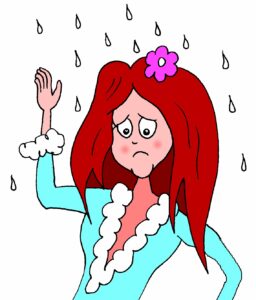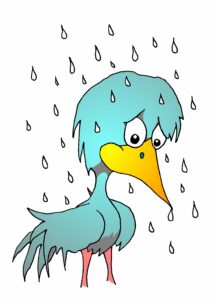 As children, our parents read us Hans Christian Andersen fairy tales such as Thumbelina, The Princess and the Pea, and The Little Mermaid, just to mention a few. The problem is they didn’t always have happy endings. For example, in The Red Shoes Karen has her feet cut off to teach her not to be jealous! Did your parents read you that one?
As children, our parents read us Hans Christian Andersen fairy tales such as Thumbelina, The Princess and the Pea, and The Little Mermaid, just to mention a few. The problem is they didn’t always have happy endings. For example, in The Red Shoes Karen has her feet cut off to teach her not to be jealous! Did your parents read you that one?
Another interesting one is the tale of The Ugly Duckling. This the experts believe is about Andersen’s own feelings of his childhood when at school he was teased about his appearance. He felt isolated just like the Ugly Duckling. The story he wanted to tell everyone is that you can eventually turn into a beautiful swan. He chose the swan as he was convinced that in later life, once he won fame, he would feel like a swan because as a successful writer he was able to mix in the highest circles.
 Each of his books has a message in them. Unfortunately, sometimes that message is put forward in the most painful way, to make the message hit home.
Each of his books has a message in them. Unfortunately, sometimes that message is put forward in the most painful way, to make the message hit home.
Of course, these were different times and people were harsher in those days. You see this was just after the Napoleonic wars and many experts feel that it was the aftereffects that led to the morals in his stories. Of course, no one really knows.
He was born on April 2nd, 1805, in Odense, Funen, in the Kingdom of Denmark and Norway, which later became Denmark. There he had a hard upbringing. His father died when he was 11, which meant that he had to go out to work to support his mother. Unfortunately, he was born with a high-pitched squeaky voice, which meant he was continually teased at school.
To which we must add that we now know that he was born with dyslexia, which unfortunately wasn’t understood in those days. As one who is also dyslexic, I know how difficult life can be, especially when people don’t understand it, as in those days they didn’t. However, he did learn to read, but his spelling was dreadful with the result that his handwriting was peppered with mistakes. Again, I understand this. Fortunately for me I have something they didn’t have in his day, my spell checker!
What is interesting is the effect this had on his writing style. He came over as if he was talking to you, and this, they say, is why his stories even today still sound fresh.
Recently, I re-read some of his stories, which led me to do a survey of bookshops to ask how often they sold his books. Now, this was interesting. They all sold them, but only once! It appears parents tended to buy one and then didn’t come back for any more Hans Andersen books, they did look for other children’s books. We therefore decided to rewrite them, keeping the moral of the story but giving it a happy ending.
The result is that so far we have re-written:
- The Princess and the Peas
- The Emperor’s new Clothes
- The Red Shoes
- The Little Mermaid
- The Ugly Duckling
All of which you can find and download at https://www.amazon.co.uk/s?k=anthony+james+-+hans+andersen&ref=nb_sb_noss as superb books for children to read on holiday.
Coming along soon will be:
- The Little Match Girl
- Little Thumbelina
- Ida’s Little Flowers
Finally, did you know that International Children’s Book Day, held every year on April 2nd is in honour of Andersen’s birth date?
Isn’t history interesting?
10 questions to discuss:
- Beyond the examples mentioned, are there other Andersen fairy tales with dark or ambiguous endings, and how do they compare to the rewritten versions with happy endings?
- The blog suggests a connection between Andersen’s personal experiences and the themes in his stories. Can you identify specific examples from his life that influenced specific stories or characters?
- The blog mentions the Napoleonic Wars’ as a possible influence on the morals in Andersen’s stories. Are there other historical or social factors that might have contributed to the harshness or darkness found in some tales?
- How did Andersen’s dyslexia impact his writing style beyond the conversational tone mentioned in the blog? Did it influence his storytelling techniques or thematic choices?
- The blog mentions a survey of bookshops. What were the specific reasons parents gave for not buying more Andersen books after purchasing one?
- Beyond the rewritten stories mentioned, are there any ethical concerns or potential drawbacks to adapting classic fairy tales with happier endings?
- How do the rewritten versions handle the original stories’ moral messages or social critiques? Are they preserved, adapted, or replaced with new lessons?
- The blog mentions International Children’s Book Day. How is Andersen’s legacy celebrated on this day, and what are its broader implications for promoting children’s literature?
- Are there any other authors or fairy tale collections that explore similar themes of hardship, perseverance, and self-discovery as Andersen’s stories?
- How can parents, educators, and readers approach classic fairy tales, like Andersen’s, to ensure they spark meaningful conversations and critical thinking about complex themes, even if they don’t have universally happy endings?
To learn more about him go to:
http://visitandersen.com/hans-christian-andersen-biography
https://www.mentalfloss.com/article/579239/hans-christian-andersen-facts
© Tony Dalton

